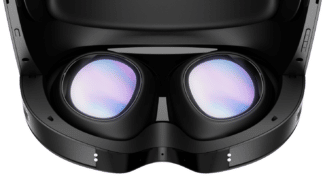Meta claims it created the supply chain for Quest Pro’s pancake lenses “from scratch”.
Pancake lenses use polarization to “fold” the optical path, and thus support a shorter gap to the displays, enabling headsets with slimmer visors. Quest Pro wasn’t the first headset to incorporate pancake lenses – Pico 4 shipped the week before, and HTC’s Vive Flow over a year ago.
But Meta claims its optics are “truly unique”, with two lens elements and more than 10 layers of “functional optical films”. In a blog post published today where Meta brands Quest Pro’s display and optics stack ‘Infinite Display’, the company explained the multi-year process it took to take these lenses from a research concept to a shipping component:
The original concept was developed by Reality Labs Research over the course of about two years, and it represents a highly successful hardware tech transfer from research to product in VR. However, there was more work to be done to design pancake lenses and polarization optics that would work in product—a process that took roughly four years, including more than a year during which the product and research teams worked as a single integrated team to ensure a successful and efficient transfer.
While our research teams are able to build time machines—prototypes that show what might be possible five to 10 years or more into the future, without regard for constraints like cost, weight, and more—our product teams must deliver a viable design that can be produced at scale. Far from off-the-shelf products, the product team designed truly unique lenses and polarization stacks. While pancake lenses and polarization optics are in themselves nothing new, their application for VR poses unique challenges in productization at scale. There was no manufacturer that made the parts, which required incredibly precise lens and polarization film fabrication and integration, so our product teams had to work closely with the industry over the course of years to create the supply chain from scratch and advance their state-of-art manufacturing capabilities. We were among the first to work with tier 1 industrial partners to create a shortened optical stack and pancake optics like Meta Quest Pro’s—and we did it at scale.

Given the significant investment of time and money in building out a supply chain for new lenses, it doesn’t make sense to only use them in one headset. When Facebook last introduced new VR lenses, in 2018’s Oculus Go, it continued to use them in Rift S, Quest, and Quest 2. The blog post ends by alluding to Quest Pro’s lenses being combined with higher resolution displays in the future. Given Quest 3 is slated for later next year, it seems very likely it too will use these new lenses.





